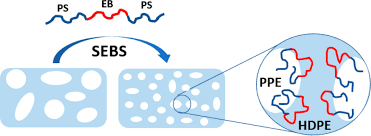Introducción
A synthetic elastomer called SEBS (Styrene-Ethylene-Butylene-Styrene) is produced by copolymerizing styrene and butadiene with the addition of ethylene as a co-monomer. Because of their superior mechanical qualities and good permeability resistance, SEBS copolymers are used in a wide range of industries, including the construction, automotive, and packaging sectors. In order to create suitable blends, SEBS-g-MA (Styrene-Ethylene-Butylene-Styrene-graft-Maleic Anhydride) can be grafted onto polyolefins that have been modified with maleic anhydride. This is one of the most important uses of SEBS copolymers.
In order to increase interfacial adhesion and the mechanical characteristics of the blends, SEBS-g-MA is applied to maleic anhydride-modified polyolefins (MAH-POs) in this work. We will discuss the benefits of employing SEBS-g-MA as a compatibilizer as well as the several ways to make graft copolymers. In addition, we will contrast the SEBS-g-MA improved polymer blends with their unaltered counterparts in terms of their physical, chemical, and mechanical characteristics.
Graft Copolymer SEBS-g
SEBS-g-MAH, a SEBS copolymer grafted with maleic anhydride, is frequently employed as a compatibilizer in polymer blends. The molecular bridge created by the graft copolymer between the incompatible polymer chains enhances the mechanical and interfacial adhesion qualities of the blends.
The SEBS copolymer is created by copolymerizing styrene, ethylene, and butylene in the presence of a peroxide initiator during the making of SEBS-g-MAH. The SEBS-g-MAH graft copolymer is created by reacting the SEBS copolymer with maleic anhydride in the presence of radical initiators.
One benefit of utilizing SEBS-g-MA as a compatibilizer is that it can increase the polymer blends’ toughness and impact strength without noticeably lowering their tensile strength or stiffness. This is so that a homogenous blend with enhanced mechanical qualities may be produced as a result of SEBS-g-MA’s better compatibility between the polymer chains.
SEBS-g-MA is applied to MAH-POs.
The plastics industry makes extensive use of polyolefins like polyethylene (PE) and polypropylene (PP) because of their low cost, light weight, and superior processability. Their applicability is nonetheless restricted to some sectors due to their poor mechanical qualities, which include low impact strength and poor thermal stability. Maleic anhydride (MAH) can be grafted onto polyolefins to enhance compatibility and interfacial adhesion between the polyolefin chains in order to get around these restrictions.
When MAH is added to polyolefins, polar functional groups are produced that can interact with other polar species, such as the SEBS-g-MA graft copolymer, to establish a potent interfacial connection between the polymer chains. This makes the polymer blend’s mechanical characteristics better by making it less brittle and more robust and impact-resistant.
SEBS-g-MA may be blended with MAH-modified polyolefins in a variety of ways, including melt blending, solution blending, and reactive processing. In a melt compounding extruder, the SEBS-g-MA and MAH-POs are combined during melt blending. In order to blend a solution, the SEBS-g-MA and MAH-POs must first be dissolved in a solvent before being combined. In reactive processing, a reactive compatibilizer is used to create a covalent link between the polymer chains of the MAH-POs and SEBS-g-MA.
The qualities of the polymers, the processing circumstances, and the intended use all influence the choice of blending technique. Reactive processing is favored for more specialized applications where greater control of the reaction is required, however melt blending is still the approach employed for industrial applications most frequently due to its simplicity.
SEBS-g-MA Enhanced Polymer Blends: Properties
It has been demonstrated thatSEBS-g-MAH considerably enhances the mechanical characteristics of blends of MAH-modified polyolefins. By grafting the SEBS-g-MA onto the MAH-POs, the interfacial adhesion between the polymer chains is strengthened, resulting in a more uniform mix with increased toughness and impact strength.
Tensile testing, impact testing, and dynamic mechanical analysis (DMA) were used to examine the mixes’ mechanical characteristics. While the stiffness remained mostly unchanged, it was discovered that the addition of SEBS-g-MAH increased the tensile strength and elongation at break. A large rise in impact strength suggests that the mixes’ toughness has improved.
The blends’ thermal stability was also assessed, and it was discovered that the inclusion of SEBS-g-MA enhanced that stability by halting deterioration at high temperatures.This is due to the SEBS-g-MA’s capacity to suppress chain scission and function as a heat stabilizer by preventing radical production.
To increase the interfacial adhesion and mechanical characteristics of polymer blends, graft copolymer SEBS-g-MA is frequently employed as a compatibilizer. Maleic anhydride-modified polyolefins get increased toughness, impact strength, and thermal stability when SEBS-g-MA is added to them.
Several techniques, including melt blending, solution blending, and reactive processing, can be used to create SEBS-g-MAJ. The qualities of the polymers, the processing circumstances, and the intended use all influence the choice of blending technique.
In general, SEBS-g-MAH is a useful tool for improving and changing the characteristics of polyolefins, enabling increased usage of these materials in a wider variety of applications. SEBS-g-MA technology will continue to progress, allowing for new developments in the compatibilization and modification of plastics.












